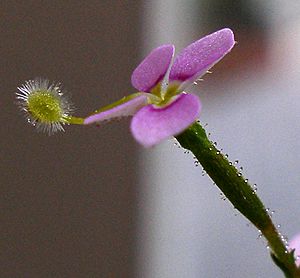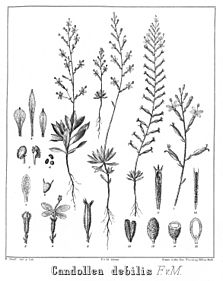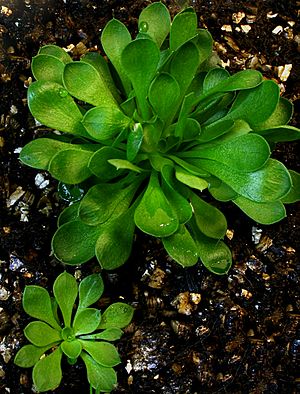Frail triggerplant facts for kids
Quick facts for kids Frail triggerplant |
|
|---|---|
 |
|
| Scientific classification | |
| Genus: |
Stylidium
|
| Species: |
debile
|
| Synonyms | |
|
Candollea debilis
|
|
The frail triggerplant, also known as Stylidium debile, is a special carnivorous plant. This means it eats insects! It's a type of plant that belongs to the Stylidium genus. This plant is found only in coastal areas of Queensland and New South Wales, Australia. This makes it an endemic species, meaning it naturally grows nowhere else in the world.
Contents
What the Frail Triggerplant Looks Like
The frail triggerplant is a small plant that grows from 15 to 30 centimeters (about 6 to 12 inches) tall. It's usually an annual plant, meaning it lives for only one year.
This plant has many leaves, usually between 20 and 200 per plant. These leaves are shaped like a spoon or an egg, and they grow in a circle close to the ground. This circular arrangement of leaves is called a rosette.
The frail triggerplant also grows one or two tall flower stalks, called scapes. These stalks can be 10 to 25 centimeters long. They produce pretty pink flowers. In their natural home, these flowers can bloom all year round.
Where it Grows
Historically, the frail triggerplant was found in many places across Queensland and New South Wales. This included areas like the Atherton Tableland and near Sydney. However, many of these places have changed a lot. Because of this, the plant might not grow there anymore.
Today, you can find the frail triggerplant from Blackdown Tableland in Queensland down to the area around Coffs Harbour in New South Wales. It likes to grow in sandy soil or pale, silty clay. You can often find it near creek banks or in swampy areas. It often grows alongside trees like Melaleuca quinquenervia and Lophostemon suaveolens.
Scientists have looked at the plant's numbers. They believe its conservation status is secure, meaning it's not currently in danger of disappearing.
How Scientists Name Plants

When scientists first named the frail triggerplant, they gave it the name Stylidium debile. Over time, they sometimes change how plants are grouped and named.
This plant used to have two different types, or "varieties," listed under its name:
- Stylidium debile var. debile
- Stylidium debile var. paniculatum
In 1905, two scientists, Joseph Maiden and Ernst Betche, described the differences between these two varieties. Later, in 1999, another scientist named Anthony Bean decided that S. debile var. paniculatum was different enough to be its own species. He gave it the new name Stylidium paniculatum. This change meant that the original S. debile variety didn't need a special "var. debile" name anymore.
Growing Your Own Triggerplant
The frail triggerplant is one of the few Stylidium species that people can grow at home. It's grown in similar ways to other tropical Australian carnivorous plants, like Drosera (sundews).
You can grow new plants by dividing the small "clones" or "daughter" plants that grow from the root system. Even though it might live for only a year in the wild, when grown by people, it often lives for many years. This means it can be a perennial plant in cultivation.
See also
 In Spanish: Stylidium debile para niños
In Spanish: Stylidium debile para niños


